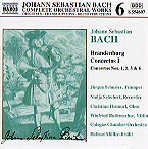No self-respecting musicians or record companies would presume to offer less than carefully considered performances of Bach’s Brandenburg Concertos; the competition on disc is simply too forbidding and listeners know these scores too well. This new series of the complete orchestral works of Bach from Naxos keeps to that precept. And what we get, at least based on these Brandenburg Concertos, are performances with a point of view–performances that find themselves striking a kind of balance between period instrument/authentic practice and the expectations of modern ears and the practicalities of 21st century concert halls. Technically, the playing (on modern instruments) is first rate; however, many listeners will find some of the interpretive choices, particularly regarding tempos, to be problematic.
Since the advent of the period performance movement, speed has all too frequently become associated with authenticity. Of course, this tendency is partly to do with the mechanics and playing techniques of Baroque strings, but practically speaking, written tempo indications in 18th century music are only relative. In fact, the “correct” tempo for a given movement or work (unless the piece is to be used strictly as a particular type of dance) is best determined by knowledge of a composer’s or period’s notation practices (the meaning of half notes in Alla breve versus 32nd notes in an Adagio, for example), as well as the nature of the texture, texts (if any), the capabilities and temperament of the performers, the types of instruments required, and even acoustics. Everyone knows when a tempo “feels” right, and that’s what we get only some of the time from Helmut Müller-Brühl and his Cologne players.
The slow movement of No. 2 is played as a zippy dance; the first movement of No. 3 is a scurrying rush–but to where? Yes, Bach gave no tempo indication for this movement, and it’s a common mistake to play it so fast that the texture just becomes a wall of sound rather than a tapestry of distinctly discernable melodic threads. So, not surprisingly, articulation here–and in the frantic Allegro–is fuzzy, and the linear clarity is lost. Likewise, the final movement of No. 6 threatens to tumble at any moment, like a slalom skier who just barely hangs on to every turn–which makes for anxious watching, and listening. And when you play fast movements even faster, what happens to the slow ones? If you play them slowly enough to let Bach’s artful lines really sing and the inner parts work their magic, the surrounding fast sections seem ludicrous. If you speed them up, you lose all of the music’s intricacy and character. Listeners who prefer this sort of determined, driven intensity in their Bach most likely will find these performances suitable, even exciting. But I would challenge them to listen first to the Linde-Consort’s more moderately paced but no less ardent treatment and Tafelmusik’s notably faster but far better-articulated interpretations.
































